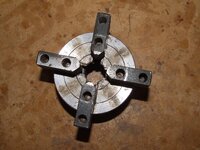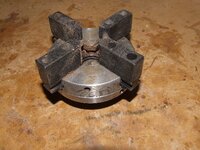This question has been around the forum several times... everyone has their own method/procedure that works for them. I drill all of my blanks square simply because it's faster for me. I have a little CMG3 chuck from PSI that I use that has some different type of jaws... the jaws came with the chuck when I bought it years ago when I first started... I'll show a picture of it below.
Using these jaws, I can pretty much drill any blank on the lathe, even irregular and out of square blanks.... I mark the approximate center of the blank... I just use a line of sight from corner to corner to make an "x" on the end where the drill will start.... I use the brad point drills most of the time and place the point in the center of the "x", hold it in place while I slide the tail stock up to the headstock and align the blank in the jaws of my chuck. Again, I use a line of sight alignment to see if the drill bit will go through the blank in the center or as near the center as possible... I don't usually do a lot of segment blanks, so absolute perfection down the center isn't a factor for me. Once I'm satisfied with the alignment, I tighten the jaws enough to hold the blank in place both horizontally and vertically.. some woods are harder than others and the pressure of the drill bit will cause the blanks to slide into the jaws... you want to be tight enough to prevent that, but not so tight as to compress the wood too much as it can bind the bit or even distort the drilled hole. I also generally leave a little space between the end of the blank and the body of the chuck so I can see when the bit clears the end of the blank.... a number of turners don't go all the way through the blank, but stop short and then cut the last 1/4 inch or so off to prevent chip out when the bit emerges... I'll do that with acrylics sometimes, but often I just allow extra length at the end of the blank in case there is a little chip out... either way works for me.
This is the little chuck I mentioned...


